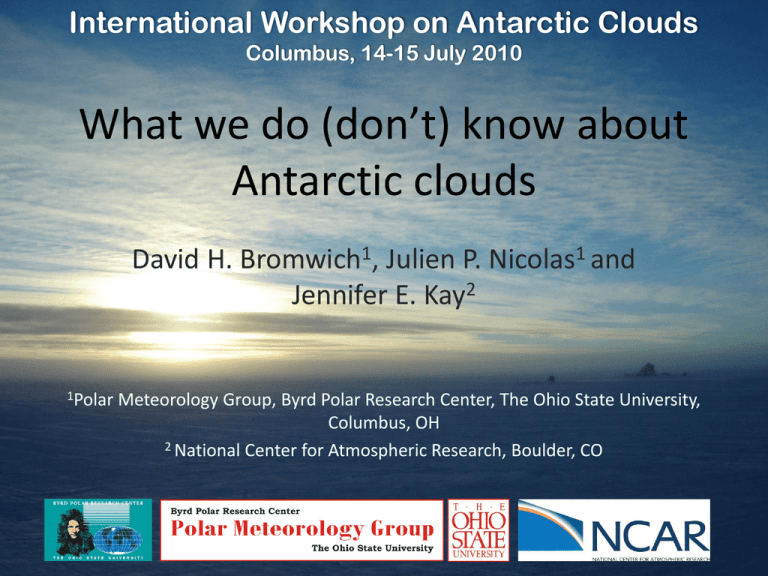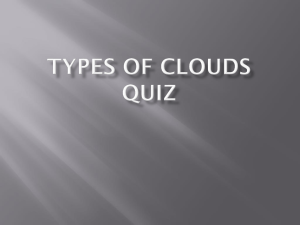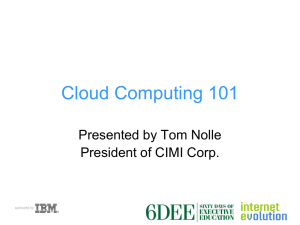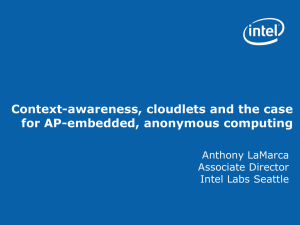(don`t) know about Antarctic clouds?
advertisement

International Workshop on Antarctic Clouds Columbus, 14-15 July 2010 What we do (don’t) know about Antarctic clouds David H. Bromwich1, Julien P. Nicolas1 and Jennifer E. Kay2 1Polar Meteorology Group, Byrd Polar Research Center, The Ohio State University, Columbus, OH 2 National Center for Atmospheric Research, Boulder, CO Outline • • • • • • • Introduction Observation methods Cloud spatial distribution (horizontal/vertical) Temporal (seasonal) variability Physical properties (phase) Trends/observed changes Conclusions Introduction Why knowledge of Antarctic is important Antarctic radiative budget 1. Clouds reflect solar energy 2. Clouds absorb long-wave radiation emitted from the surface Over high-albedo surfaces, the short-wave flux absorbed at the surface is already small: effect 2 > effect 1 Impact on Antarctic surface mass balance Role of stratospheric clouds in ozone depletion – Polar stratospheric clouds support chemical reactions conducive to the destruction of stratospheric ozone Observing Antarctic clouds Ground-based measurements • Dedicated effort to study and measure Antarctic clouds – South Pole Atmospheric Radiation and Cloud LIDAR Experiment (SPARCLE) 1999-2001 • Instruments: – – – – Polar Atmospheric Emitted Radiance Interferometer (PAERI) Tethered Balloon System Micropulse Lidar South Pole Transmissometer • Results: – Climatology of clouds (e.g., M. Town) – Cloud microphysics (e.g., V. P. Valden) Ground-based measurements • Visual observations CLOUD COVER AT SOUTH POLE (MONTHLY MEANS) – Provide the longest observational record of Antarctic clouds – Problem in winter (underestimation of cloud cover) • More about groundbased cloud observations with Erika Key and Irina Gorodetskaya PAERI pyrgeometer visual [Town et al.,2007] Passive remote sensing • VIS/IR channels • But cloud tops have albedo and temperature comparable to ice sheet’s surface Weak contrast on satellite imagery over ice-covered surface Problematic for detection of Antarctic thin clouds [Image: AMRC/SSEC/UW Madison] Active remote sensing: Lidar McM Morley et al., 1989 SP • Lidar measurements onboard an LC-130 flown between McM and South-Pole, Jan. 1986 • Multilayering of clouds • Ice crystals trails from high-elevated cirrus observed to “seed” the mid-level clouds Active remote sensing: Lidar • Ex.: Geoscience Laser Altimeter System (GLAS) on ICESat Backscatter cross-section from GLAS over Antarctica at 15:00 UTC, 1 Oct. 2003 [Spinhirne et al., 2005] Active vs passive cloud remote sensing Cloud frequency over Antarctica in Oct. 2003 from GLAS, MODIS and ISCCP [Hart et al., 2006] Cloud frequency from GLAS and HIRS (NOAA-14) from Oct. 1-Nov. 16 2003 [Wylie et al. 2007] More about cloud satellite remote sensing with Dan Lubin Mean cloud distribution 2007-08 mean seasonal cloud fraction (from Cloudsat radar/Calipso lidar) 2007 2008 Cloud cover over West Antarctica • Tongue of higher cloud fraction/frequency over central West Antarctica seen in Oct. 03 and in the 06-07 annual mean • Denotes the frequent intrusions of marine air inland associated with the cyclonic activity over the Ross/Amundsen Seas. Cloud frequency over Antarctica in Oct. 2003 GLAS Lidar AMPS [Spinhirne et al. 2005; Nicolas and Bromwich, 2010] AMPS cloud fraction 2006-2007 Cloud cover climatology Coastal areas: McMurdo • Mean seasonal cloud cover over McMurdo area in Jun 02-May 03 from AMPS forecasts [Monaghan et al., 2005] • Cloud cover primarily influenced by the presence of open water in the Ross Sea • Maximum cloud cover in DJF/MAM , minimum in JJA • Cloudiest region found over the quasi-permanent polynya (N-E of McM) JJA 02 SON 02 DJF 02-03 MAM 03 [Monaghan et al., 2005] Cloud vertical profile: West Antarctica (from Cloudsat/Calipso) 2007 2008 Cloud vertical profile: East Antarctica (from Cloudsat/Calipso) 2007 2008 Polar Stratospheric Clouds (PSCs) GLAS backscatter ratio for Sept. 29 (top) and 30 (bot.), 2003 (western Dronning Maud Land sector) Tropopause PSCs: linkages to troposphere • Formation of PSC associated with deep tropospheric cloud systems: – Cooling of the lower stratosphere through adiabatic and radiative processes – Air transport from the lower troposphere up to the upper tropo. / lower stratosphere • Figure: Measurements from CloudSat/CALIPSO. Example of a deep cloud system associated with a PSC system in the Weddell Sea West Antarc. Ross Sea Height (km) Weddell Sea [Wang et al., 2008] Offshore synoptic system penetrating over the Antarctic interior • Some deep synoptic weather system do penetrate over the Antarctic interior • Figure: Mosaic of AVHRR images of East Antarctica on Dec. 29 2001 showing a blocking-high related cloud band [Massom et al., 2004] Cloud microphysics Cloud microphysics • Measurements with the PAERI allow for the retrieval of cloud microphys. properties • Figure: relative occurrence of different cloud types in Feb. 01 at South Pole Cloud types at South Pole [Ellison et al., 2006] Cloud microphysics • Measurements from tethered balloon at South Pole on 2 Feb. 2001 [Valden et al., 2005] super-cooled water clouds Pressure (hPa) Temperature -30°C ~450m above sfc RH wrt. water Cloud microphysics • Discrimination cloud phase on a global scale possible through Space-borne lidar measurements Ice cloud observations from CALIPSO/CALIOP lidar, Jan. 2007 [Hu et al., 2009] Cloud microphysics: climatic impact • Lubin et al. (1998) evaluated the impact of changes in cloud properties over Antarctica • 10-μm ice clouds vs (control) 10-μm water clouds: [Lubin et al., 1998] Long-term changes in Antarctic cloud cover? Trends in Antarctic cloud cover • Decadal changes in cloud cover based on long-term records of visual observations at some Antarctic stations allow . But large significant uncertainty, esp. in winter. South Pole Syowa [Yamanouchi et al., 2007] [Town et al., 2007] Trends in Antarctic cloud cover • Mean monthly anomalies in cloud fraction 1982-1999 based on AVHRR observations [Comiso and Stock, 2001] • Negative trends in cloud fraction: -0.50 ± 0.06% (ice sheet >2000m) -0.21 ± 0.04% (ice sheet <2000m) -0.09 ± 0.03% (sea ice area) -0.06 ± 0.01% (open ocean) PSCs and tropospheric warming • Significant mid-tropospheric warming has been observed in winter over Antarctica • The warming may be related to larger amounts of PSCs induced by increased tropospheric CO2 concentration and the associated stratospheric cooling [modeling studies from Lachlan-Cope et al., 2009] Trends in mid-tropospheric temp. At Ant. Stations (1971-2003) At 500-hPa from ERA-40 (1979-2001) [Turner et al., 2006] 600hPa Conclusions • Antarctic cloud studies are in a new era with the spaceborne observations (CloudSat, CALIPSO) • Validation is needed in the full range of Antarctic environments • The record is short and temporal resolution is limited References • • • • • • • • • Comiso, J. C and L. V. Stock, 2001: Studies of Antarctic cloud cover variability from 1982 through 1999. Proc. of the Int. Geosci. and Remote Sensing Symposium, vol. 4, 1782-1785. Ellison, M. E., et al., 2006: Properties of water-only, mixed-phase, and ice-only clouds over the South Pole. Proceedings of the 12th conference on cloud physics and 12th conference on atmospheric radiation, 9–14 July 2006, Madison, WI, Amer. Meteor. Soc. (ed), Boston, MA Hart, W. D., et al., 2006: Global and polar cloud cover from the Geoscience Laser Altimeter System, observations and implications. Extended abstract of the 12th Conference on Atmospheric Radiation, AMS, Madison, 2006. Hatzianastassiou, N., et al., 2001: Polar cloud climatology from ISCCP C2 and D2 datasets. J. Climate, 14, 3851-3862. Hines, K. M., et al., 2004: Antarctic clouds and radiation within the NCAR climate models. J. Climate, 17, 1198-1212. Hu, Y., et al., 2009: CALIPSO/CALIOPcloud phase discrimination algorithm. J. Atmo. Ocean. Tech, 26, 22932309. Lachlan-Cope, T. A., et al., 2009: Antarctic wintertropospheric warming – the potential role of polar stratospheric clouds, a sensitivity study.Atmos. Sci. Let., 10, 262-266. Morley, B. M., et al., 1989: Airborne lidar observations of clouds in the Antarctic troposphere. Geophys. Res. Lett., 16(6), 491-494. Lubin, D., et al., 1998: The impact of Antarctic cloud radiative properties on a GCM climate simulation. J. Climate, 11, 447-462. References (cont.) • • • • • • • • • Massom, R.A., et al., 2004: Precipitation over the interior East Antarctic Ice Sheet related to mid-latitude blocking-high activity. J. Climate, 17(10), 1914–1928. Nicolas, J. P. and D. H. Bromwich, 2010: Marine signature in West Antarctica. J. Climate, in press. Palm, S. P., et al., 2005: Observations of Antarctic polar stratospheric clouds by the Geoscience Laser Altimeter System. Geophys. Res. Lett., 32, L22S04. Spinhirne, J. D., et al., 2005: Antarctica cloud cover for October 2003 from GLAS satellite lidar profiling. 32, L22S05. Town, M. S., et al., 2007: Cloud cover over the South Pole from visual observations, satellite retrievals, and surface-based infrared radiation measurements. J. Climate, 20, 544-559. Walden, V. P., et al., 2005: Properties of super-cooled water clouds over South Pole. Preprints, Eighth Conf. on Polar Meteorology and Oceanography, San Diego, CA, Amer. Meteor. Soc. Wang, Z., et al., 2008: Association of Antarctic polar stratospheric cloud formation on tropospheric cloud systems. Geophys. Res. Lett., 35, L13806. Wylie, D., et al., 2007: A comparison of cloud cover statistics from the GLAS lidar with HIRS. J. Climate, 20, 4968-4981. Yamanouci, T. and Y. Shudou, 2007: Trends in cloud amount and radiative fluxes at Syowa Station, Antarctica. Polar Science, 1, 17-23. Thank you








